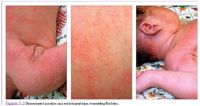Case: A 9-day-old with disseminated pustules
An afebrile baby presents with disseminated pustules on the trunk, face, and extremities.
» How would you treat him?
» What's the diagnosis?

Clinical findings
Erythma toxicum neonatorum (ETN) occurs in 30% to 70% of newborns, and usually presents between the first and fourth days of life. The vesiculopustular rash consists of white-yellow lesions with surrounding erythema and typically lasts two to three days. The asymptomatic lesions appear predominately on the trunk, but may involve the extremities, and usually spare the palms and soles.1 ETN is seen in newborns up to 2 weeks of age.2,3
Etiology
Although the underlying cause remains uncertain, the presence of eosinophils may provide a clue.4 Proposed etiologies include a graft-versus-host reaction induced by maternal cells, skin reaction to perinatal mechanical and thermal stimulation, and obstruction of sebaceous glands.3 No specific allergen or infection has been linked to ETN. A recent epidemiologic study showed that term gestation, vaginal delivery, and formula feeding were associated with higher rates of ETN.1 There are no known short-or long-term complications associated with ETN. The eruption usually resolves with two to three days without treatment.
Differential diagnosis
Although ETN is common and often viewed as a normal variant in the nursery, consider a wide differential for vesiculopustular rashes, especially with an atypical presentation.
Transient neonatal pustular melanosis differs from ETN in that it presents with pustules that are more impressive than erythema, and with evidence of lesions present at birth. The lesions can appear on any surface, including the palms and soles, and regress by 2 weeks of age, often leaving hyperpigmented skin. Eosinophilic pustular folliculitis may present in the newborn period, with yellow pustules on erythematous bases localized mostly to the scalp. Lesions usually resolve in several days, but may recur in crops during infancy. Neonatal acne, also known as benign cephalic pustulosis, may result from maternal hormonal stimulation, and occurs in about 20% of newborns. The pustular lesions are localized to the face and typically resolve by 3 months of age.5
Suspicion of an infectious agent warrants culture of the lesion, and likely further infectious workup with possible IV medications. Neonatal herpes simplex virus (HSV) infection usually manifests with grouped vesicles or crusted papules, but more widespread lesions may occur. HSV onset peaks around 10 to 12 days of life, and is likely to also present with fever, lethargy, and poor feeding.6
Neonatal varicella zoster virus (VZV) infection may also present with fever, and vesicular lesions that may coalesce and become hemorrhagic. Severe VZV infection may lead to other organ involvement. Bollous impetigo can present with one or more pustular lesions with surrounding erythema, and is likely to be caused by Staphylococcus aureus. Congenital candidiasis may present with papulovesicles and erythema soon after birth, often with palm and sole involvement.5
Milia often presents on the face with 1-to 2-mm firm papules. It is caused by retention of keratin in the dermis, with eventual resorption and subsequent resolution, usually in the first month of life. Miliaria is caused by sebaceous gland obstruction at different levels. Miliaria crystallina results from distal obstruction of eccrine ducts, and presents with 1-to 2-mm vesicles. There is no erythema, and the lesions disappear as desquamation occurs over hours to days. Miliaria rubra results from a more proximal obstruction, often associated with heat, occuring in covered areas. It presents with erythematous papules and vesicles.7 Incontinentia pigmenti is an X-linked dominant condition, occurring mostly in females. It presents in the first few weeks of life, with inflammatory linear pustules along the lines of Blaschko.
Recognize & Refer: Hemangiomas in pediatrics
July 17th 2019Contemporary Pediatrics sits down exclusively with Sheila Fallon Friedlander, MD, a professor dermatology and pediatrics, to discuss the one key condition for which she believes community pediatricians should be especially aware-hemangiomas.